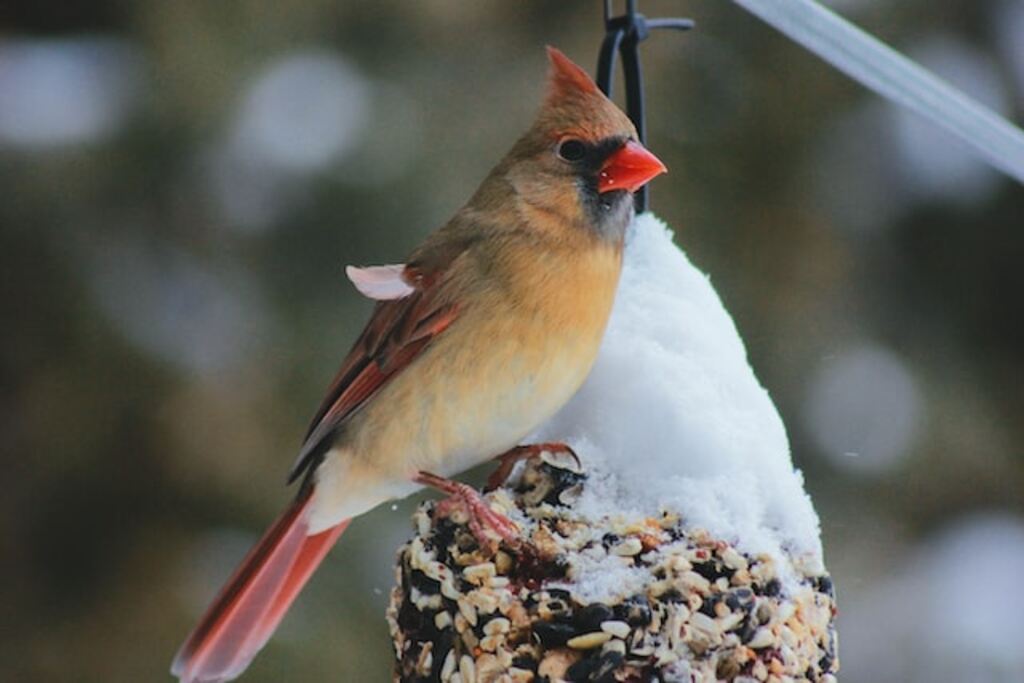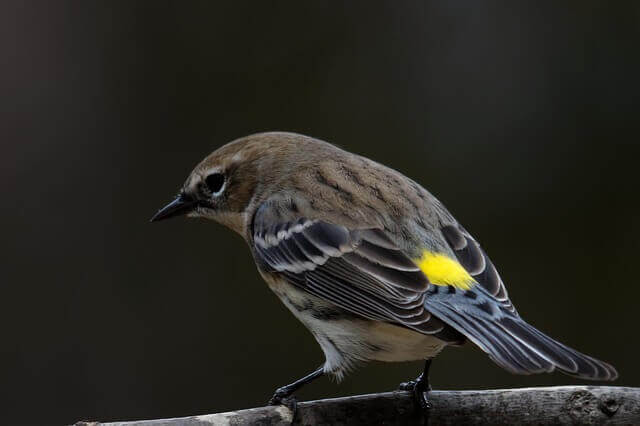Embark on a winter birdwatching adventure in Maryland with our expert guide featuring 25 backyard bird species! From the iconic Northern Cardinal to the elegant White-throated Sparrow, Maryland’s landscapes are alive with avian activity during the colder months.
In this comprehensive guide, we’ll uncover the unique characteristics, habitats, and behaviors of these winter residents, offering valuable insights for birdwatchers and nature enthusiasts alike.
Table of Contents
- 1 Backyard Winter Birds in Maryland
- 1.1 Northern Cardinal
- 1.2 White-throated Sparrow
- 1.3 Carolina Wren
- 1.4 American Crow
- 1.5 Carolina Chickadee
- 1.6 Dark-eyed Junco
- 1.7 Downy Woodpecker
- 1.8 Tufted Titmouse
- 1.9 Red-bellied Woodpecker
- 1.10 Blue Jay
- 1.11 Song Sparrow
- 1.12 Mourning Dove
- 1.13 European Starling
- 1.14 White-breasted Nuthatch
- 1.15 House Finch
- 1.16 American Robin
- 1.17 American Goldfinch
- 1.18 Northern Mockingbird
- 1.19 House Sparrow
- 1.20 Eastern Bluebird
- 1.21 Red-winged Blackbird
- 1.22 Northern Flicker
- 1.23 Pileated Woodpecker
- 1.24 Hairy Woodpecker
- 1.25 Yellow-rumped Warbler
- 2 Author
Backyard Winter Birds in Maryland
Northern Cardinal
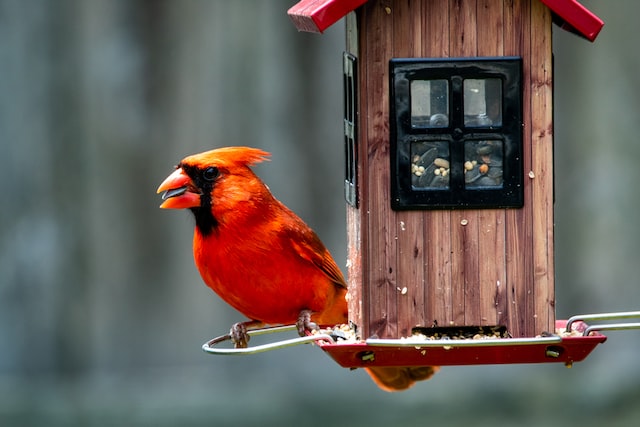
- Length: 8.3-9.1 in (21-23 cm)
- Weight: 1.5-1.7 oz. (42-48 g)
- Wingspan: 9.8-12.2 in (25-31 cm)
- Scientific Name: Cardinalis cardinalis
- Frequency of Occurrence: 53.67% (Statistic: eBird)
- Maps: Range Map – Sightings Map
- Sounds: Calls and Sounds
- Where To Find Them: In general, they tend to stay near areas with dense vegetation and trees. This provides them with shelter from the cold weather and access to food. Some specific places where you might find them include, The Baltimore and Annapolis area – This region has a lot of parks and gardens that are perfect for cardinals. Look for them near bushes and trees in these locations. The Eastern Shore – This area is known for its wetlands, which provide ideal habitat for many birds. Cardinals can often be seen in marshy areas or near bodies of water. Western Maryland – The mountains and forests of this region are home to many wildlife species, including cardinals. They can often be spotted near trails or in open meadows.
- How to Attract Them: Provide shelter from the elements. Cardinals will appreciate a dense evergreen shrub or tree for refuge from wind and snow. Offer a variety of food sources. Cardinals love sunflower seeds, but they will also eat suet, berries, and insects. Keep your feeders clean and fresh. Dirty feeders can harbor disease, so be sure to clean them regularly with hot, soapy water. Provide fresh water for drinking and bathing. A birdbath or small pond is perfect for this purpose; just be sure to keep the water from freezing over in winter weather!
General Information: Cardinals are one of the most popular birds in North America and their striking red plumage is easy to spot. These birds range from southern Canada all the way down to Mexico. In terms of habitat, cardinals can inhabit many different types of environments including woods, forests, and even backyards in urban areas.
When it comes to diet, these birds eat a variety of things including seeds, fruits, and insects. Cardinals are fun birds to watch, and their bright red color is sure to add some beauty to your day.
Related:
- Cardinal Bird Facts Every Birdwatcher Should Know!
- 10 Best Bird Feeders for Cardinals (Rated for 2022)
- Best Birdhouse for Cardinals 2022 (Tested And Rated)
White-throated Sparrow
- Length: 6.3-7.1 in (16-18 cm)
- Weight: 0.8-1.1 oz. (22-32 g)
- Wingspan: 7.9-9.1 in (20-23 cm)
- Scientific Name: Zonotrichia albicollis
- Frequency of Occurrence: 45.52%
- Maps: Range Map – Sightings Map
- Sounds: Calls and Sounds
- Where To Find Them: In Maryland, the best place to find White-throated Sparrows in winter is at Blackwater National Wildlife Refuge.
- How to Attract Them: Start by providing some basic bird food staples like black oil sunflower seeds and Millet. Put out a water source for the birds to drink and bathe in. This is especially important in winter, when natural water sources may be frozen over. Make sure your bird feeders are clean and free of mold or debris. Birds will avoid dirty feeders. Provide some cover for the birds to hide in if they feel threatened.
General Information: The White-throated Sparrow (Zonotrichia albicollis) is a songbird of the New World sparrow family. It ranges from southern Canada to northern Mexico and has been introduced to Hawaii. The White-throated Sparrow breeds in open woodlands and weedy fields. The diet of this sparrow consists of seeds, insects and spiders.
This sparrow gets its name from the white throat patch which is bordered by a black line. The head is also striped with a brown crown, white eyebrow and yellow spot in front of both eyes. The back and wings are grey with white streaks while the underparts are pale white. This small sparrow measures about 16 cm long with a wingspan of 23 cm.
Carolina Wren

- Length: 4.7-5.5 in (12-14 cm)
- Weight: 0.6-0.8 oz (18-22 g)
- Wingspan: 11.4 in (29 cm)
- Scientific Name: Thryothorus ludovicianus
- Frequency of Occurrence: 42.61%
- Maps: Range Map – Sightings Map
- Sounds: Calls and Sounds
- Where To Find Them: The Carolina Wren is a beautiful bird that can be found in many different locations throughout Maryland. However, the best place to see them in winter is definitely at the Patuxent Wildlife Research Center in Laurel. This research center is home to a variety of different wildlife, including the Carolina Wren. The staff at the center are extremely knowledgeable about the birds and their habitat, and they are always happy to help visitors get a closer look.
- How to Attract Them: One of the best ways to attract Carolina Wrens in winter is by providing them with a reliable food source. This means putting out a variety of bird seed, suet, and insects. You can also try hanging a fruit feeder, as these birds are especially fond of berries. Another way to attract Carolina Wrens is by providing them with shelter. In winter, these birds appreciate dense shrubs and evergreens where they can roost and nest. If you have a lot of trees on your property, consider leaving some dead branches in place – Carolina Wrens will often use these for nesting material.
General Information: The Carolina Wren is a small bird that is found in the southeastern regions of the United States. These birds are found in a variety of habitats, including woodlands, marshes, and suburban areas. Carolina Wrens eat insects, spiders, and other small invertebrates. Carolina wrens are relatively small songbirds with stout bodies and long tails. They have brown upperparts with rusty streaks on the back and wings.
The underparts are pale with heavy brown streaking. The face is grayish with a white eyebrow stripe. Males and females look similar, although the male may have a slightly brighter plumage. These birds range throughout the southeastern United States, from central Texas to southern Virginia. They can also be found in parts of the Caribbean.
Related: How to Attract Wrens to your Backyard? (Expert’s Guide)
American Crow
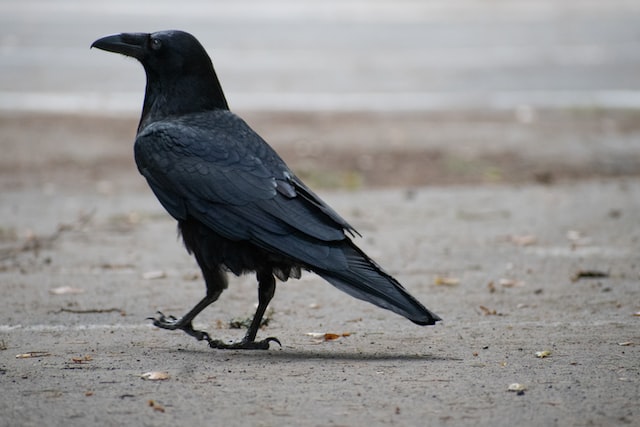
- Length: 15.8-20.9 in (40-53 cm)
- Weight: 11.2-21.9 oz. (316-620 g)
- Wingspan: 33.5-39.4 in (85-100 cm)
- Scientific Name: Corvus brachyrhynchos
- Frequency of Occurrence: 40.67%
- Maps: Range Map – Sightings Map
- Sounds: Calls and Sounds
- Where To Find Them: The best location in Maryland to see them in winter is along the Chesapeake Bay. They can also be found in fields and woods near water.
- How to Attract Them: Put out a variety of food. Crows are omnivores, so they’ll eat just about anything. A mix of fruits, nuts, and meat will give them the energy they need to survive the cold weather. Keep your garbage cans clean and lidless. Crows are attracted to easy meals, so an open garbage can is like a buffet for them. Keeping it clean will also help keep your property looking neat and tidy. Don’t shoo them away.
General Information: The American Crow (Corvus brachyrhynchos) is a bird of the family Corvidae native to North America. The range of the American Crow extends from Alaska and Canada to northern Florida. The American Crow is found in a variety of habitats including forests, woodlands, farms, and urban areas. The diet of the American Crow consists mainly of insects, but also includes fruits, nuts, carrion, and garbage.
The American Crow is a highly adaptable bird that has benefited from human activity. The bird isn’t seen as threatened or endangered. However, the American Crow faces some challenges, including West Nile virus and predation by animals such as hawks and owls.
Related: How To Attract Crows To Your Backyard: Expert Tips!
Carolina Chickadee
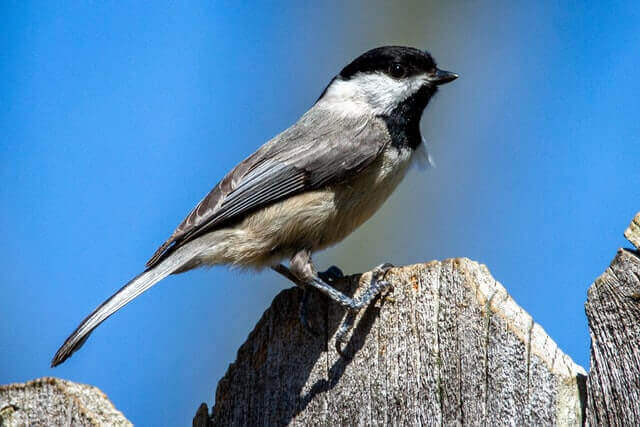
- Length: 4.7-6.0″ in (12.0-15.2 cm)
- Weight: 0.3-0.5 oz (9-14 g)
- Wingspan: 6.3-8.3 in (16-21 cm)
- Scientific Name: Poecile carolinensis
- Frequency of Occurrence: 40.59%
- Maps: Range Map – Sightings Map
- Sounds: Calls and Sounds
- Where To Find Them: There are many beautiful places in Maryland to see Carolina Chickadees in winter. They can be found near Deep Creek Lake, in the western part of the state. Another great place to see them is at Patuxent Research Refuge, located in Anne Arundel County. These little birds are also commonly seen at Blackwater National Wildlife Refuge and Susquehanna State Park.
- How to Attract Them: If you want to attract Carolina Chickadees to your yard this winter, there are a few things you can do. First, make sure to provide them with a food source. Chickadees love sunflower seeds and suet, so offer these items in a bird feeder or bird house. Secondly, provide them with shelter from the cold weather. Evergreen trees and shrubs make ideal shelters for chickadees. Finally, make sure to keep your yard clean of debris.
General Information: The Carolina Chickadee is a small, active bird found in woodlands throughout the southeastern United States. The Carolina Chickadee has a black cap and bib with white sides to its face. Its back is gray, and its underparts are whitish. The wings and tail are also gray with white bars. Carolina Chickadees are 4.7 to 6.0 inches long with a wingspan of 6.5 to 8.5 inches. They weigh about 0.5 ounces.
Carolina Chickadees breed in late winter or early spring, nesting in tree cavities or man-made nest boxes. They typically have 4-6 chicks per brood. Both parents help to feed the young birds until they fledge at about 3 weeks old. Carolina Chickadees eat insects and other small arthropods, as well as seeds, fruits, and berries.
Related: Carolina Chickadees – 9 Best Ways To Attract Them Fast!
Dark-eyed Junco
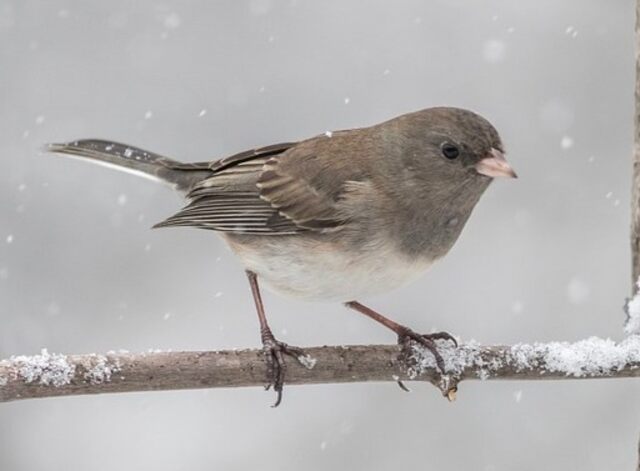
- Length: 5.5-6.3 in (14-16 cm)
- Weight: 0.6-1.1 oz. (18-30 g)
- Wingspan: 7.1-9.8 in (18-25 cm)
- Scientific Name: Junco hyemalis
- Frequency of Occurrence: 40.40%
- Maps: Range Map – Sightings Map
- Sounds: Calls and Sounds
- Where To Find Them: The Dark-eyed Junco is a small sparrow with a gray body and black wings. They are typically found in wooded areas near streams and ponds. In Maryland, the best place to find them in winter is at the Patuxent Research Refuge in Laurel. The refuge is home to over 200 species of birds, including the Dark-eyed Junco. The refuge is open year-round and offers bird-watching tours led by knowledgeable guides.
- How to Attract Them: One of the best ways to attract Dark-eyed Juncos is by providing them with food. They love seeds, so a bird feeder filled with sunflower or thistle seeds is sure to bring them in. You can also put out a dish of grits or sand for them to use during the winter months. Another way to attract Dark-eyed Juncos is by providing them with shelter. They will often roost in evergreens during the winter, so planting some evergreens in your yard will give them a place to stay.
General Information: The Dark-eyed Junco (Junco hyemalis) is a small bird in the family Emberizidae. The juncos are collectively known as “snowbirds” because they are often seen in flocks in winter. The Dark-eyed Junco has a wide range, spanning most of North America, from Alaska to Newfoundland and south to Panama.
In summer, they can be found in forests at high elevations, while in winter they move to lower elevations and open habitats such as fields and yards. The Dark-eyed Junco is a seed-eater, and its diet consists mostly of grasses and other small seeds. Some juncos also eat insects, especially during the breeding season, when they need more protein to raise their young.
Related: Fun Facts About Dark-eyed Juncos
Downy Woodpecker

- Length: 5.5-6.7 in (14-17 cm)
- Weight: 0.7-1.0 oz. (21-28 g)
- Wingspan: 9.8-11.8 in (25-30 cm)
- Scientific Name: Picoides pubescens
- Frequency of Occurrence: 36.56%
- Maps: Range Map – Sightings Map
- Sounds: Calls and Sounds
- Where To Find Them: The Downy Woodpecker can be found in forests, woodlands, and parks. In Maryland, the best places to find the Downy Woodpecker in winter are in Baltimore County and Montgomery County.
- How to Attract Them: Downy Woodpeckers are attracted to suet, so offer this high-fat food source in a suet feeder. You can also put out a platform feeder with sunflower seeds, peanuts, and other nuts. Keep your birdbath clean and filled with fresh water, as these birds also enjoy bathing. In addition to food and water, provide nesting sites by putting up nest boxes or leaving dead trees standing. By following these simple tips, you can attract Downy Woodpeckers to your yard all year long!
General Information: The Downy Woodpecker is a small North American woodpecker. The adult is 5.5 to 7 inches in length, with a wingspan of 10 to 12 inches. The body is black with white stripes on the back and wings. The head has a red patch on the back, and the male also has a red spot on the top of the head. The bill is short and black.
The Downy Woodpecker ranges from Alaska and Canada to the eastern United States and Mexico. It is found in forests, woodlands, parks, and gardens. It prefers deciduous trees, but will also use coniferous trees. The diet of the Downy Woodpecker consists of insects, spiders, berries, and nuts. It will eat insects that it finds on tree trunks and branches.
Related: How to Attract Downy Woodpeckers to Your Yard? (Easy!)
Tufted Titmouse
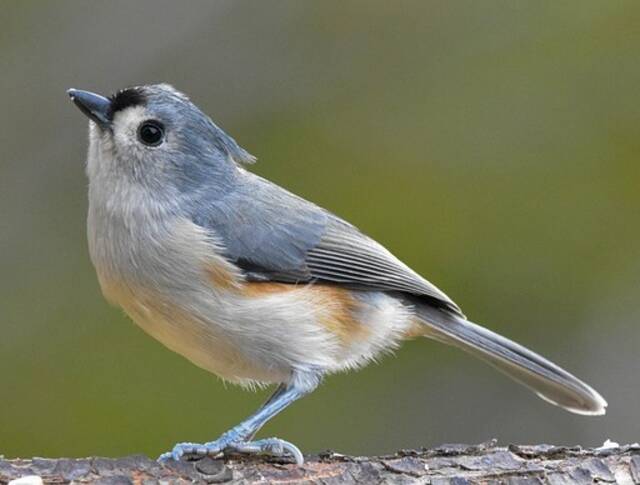
- Length: 5.5-6.3 in (14-16 cm)
- Weight: 0.6-0.9 oz. (18-26 g)
- Wingspan: 7.9-10.2 in (20-26 cm)
- Scientific Name: Baeolophus bicolor
- Frequency of Occurrence: 36.09%
- Maps: Range Map – Sightings Map
- Sounds: Calls and Sounds
- Where To Find Them: The best time of year to see Tufted Titmice in Maryland is during the winter months, when they are more likely to be found in open areas foraging for food. Some good places to look for them include Rock Creek Park in Washington, D.C., Patuxent Research Refuge in Laurel, and Seneca Creek State Park near Gaithersburg. These small birds are easily recognized by their gray plumage, black cap, and white tufts of feathers on their head.
- How to Attract Them: First, provide a food source. Titmice are especially fond of sunflower seeds, so a bird feeder filled with these is sure to attract them. You can also put out a dish of suet or offer other high-fat foods like peanuts or peanut butter. In addition to food, titmice also need water.
General Information: The Tufted Titmouse is a small songbird that ranges throughout the eastern United States. Its habitat includes woodlands, gardens, and city parks. Tufted Titmice rely heavily on insects and seeds found in their native environments. The Tufted Titmouse is a small songbird with a gray body and white underparts. It has a black cap and crest, and a black stripe down its back.
The wings are gray with white edges. The tail is long and pointed. The legs are short and gray. The bill is short and black. The Tufted Titmouse ranges throughout the eastern United States, from Maine to Florida, west to Illinois and Texas. It is a permanent resident in most of its range, although some northern birds may migrate south in winter.
Related: How to Attract Tufted Titmouse to my Yard? (Explained)
Red-bellied Woodpecker
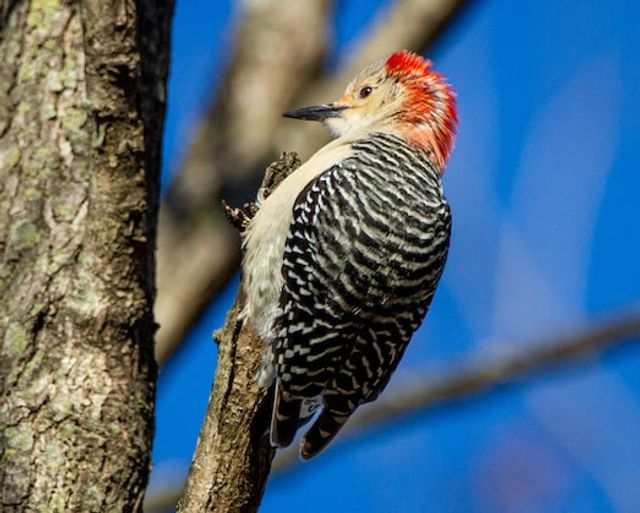
- Length: 9.4 in (24 cm)
- Weight: 2.0-3.2 oz. (56-91 g)
- Wingspan: 13.0-16.5 in (33-42 cm)
- Scientific Name: Melanerpes carolinus
- Frequency of Occurrence: 35.89%
- Maps: Range Map – Sightings Map
- Sounds: Calls and Sounds
- Where To Find Them: Rock Creek Park is one of the best places to see red-bellied woodpeckers in Maryland. This park is located just outside of Washington, D.C., and it’s a great place to bird watch all year round. There are many different species of birds that can be found here, but the red-bellied woodpecker is one of the most common.
- How to Attract Them: Here are a few tips on how to attract red-bellied woodpeckers to your yard during the cold months. Offer the right food. Red-bellied woodpeckers are mostly omnivorous, meaning they eat both plant material and small animals as well. You can offer them peanut butter or insect suet, which is especially important in winter when natural insect populations are low. Make sure there’s water available. A constant supply of fresh water is crucial for all birds, but especially so in winter, when water sources may be frozen over.
General Information: The Red-bellied Woodpecker is a common woodpecker found throughout the eastern United States. Their range extends from Maine to Florida, and as far west as Texas and the Great Plains. They are most often seen in wooded areas, but can also be found in open fields and even suburban neighborhoods.
The Red-bellied Woodpecker gets its name from the reddish color on the underside of its belly. These birds are not afraid of humans and will often approach people for food. The diet of the Red-bellied Woodpecker consists mainly of insects, but they will also eat nuts and berries. In winter, these birds will often visit bird feeders to supplement their diet.
Related: How to Attract Red-bellied Woodpeckers to your Yard?
Blue Jay
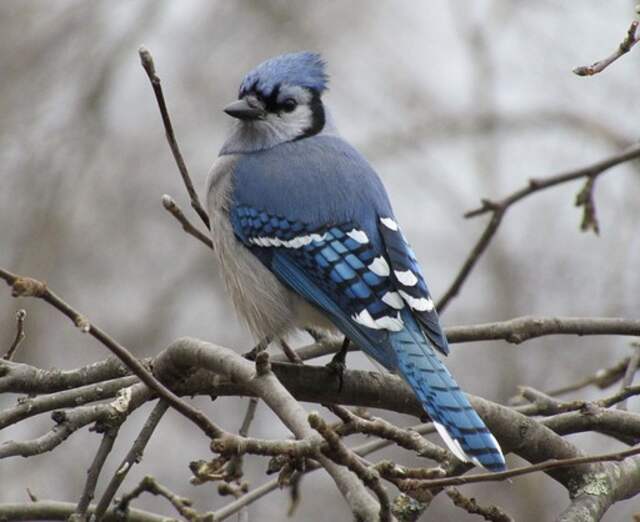
- Length: 9.8-11.8 in (25-30 cm)
- Weight: 2.5-3.5 oz. (70-100 g)
- Wingspan: 13.4-16.9 in (34-43 cm)
- Scientific Name: Cyanocitta cristata
- Frequency of Occurrence: 35.47%
- Maps: Range Map – Sightings Map
- Sounds: Calls and Sounds
- Where To Find Them: Looking for a winter getaway? How about a trip to see the Blue Jay? These beautiful birds can be found in many locations across Maryland. Here are some of the best places to see them:Point Lookout State Park – This park offers stunning views of the Chesapeake Bay and is home to a variety of wildlife, including the Blue Jay. Deep Creek Lake – This popular spot is known for its snow-covered trees and picturesque scenery. It’s also a great place to spot a Blue Jay or two. Assateague Island National Seashore – This beach is perfect for bird watching, especially in the winter when the Blue Jays come to visit. So pack your binoculars and head on over!
- How to Attract Them: One of the best ways to attract blue jays is by offering them food. During the winter months, when natural resources are scarce, supplemental food can be a key factor in bringing these birds to your yard. To appeal to blue jays, try setting out peanuts, corn, berries, and suet. You can also put out a bird feeder that is designed for larger birds and has perches for them to sit on while they eat. Another way to attract blue jays is by providing them with shelter. In winter, these birds will appreciate having places to hide from the cold and wind. Offer them evergreens, thickets, and bushes where they can take refuge.
General Information: The Blue Jay is a very popular bird that is found in North America. It has a very distinctive blue coloration with white underparts. The head has a crest on top. It is a relatively small bird, measuring around 9.5 to 12 inches in length. The wingspan is around 13 to 17 inches.
The Blue Jay is found in a wide range of habitats including forests, woodlands, and even urban areas. It typically nests in trees, often close to the ground. The diet of the Blue Jay consists mainly of insects and acorns. In the wintertime, they will also eat fruits and berries.The Blue Jay is not only a beautiful bird to look at, but it is also interesting to watch as it goes about its daily activities.
Related:
- What Attracts Blue Jays to your Yard?(Expert Tips)
- 15 Best Bird Feeders For Blue Jays (Tried & Tested 2022)
Song Sparrow
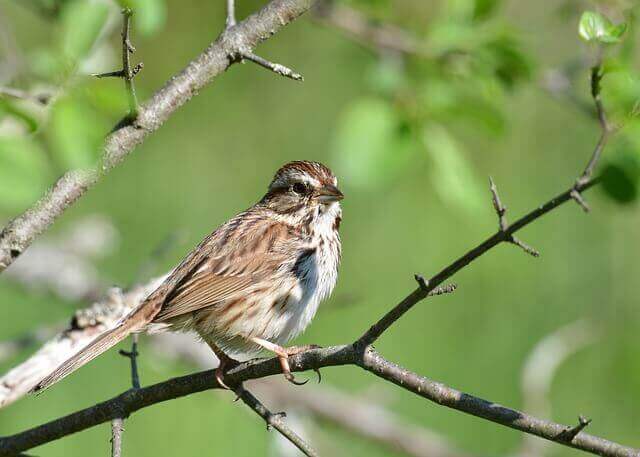
- Length:4.7-6.7 in (12-17 cm)
- Weight: 0.4-1.9 oz. (12-53 g)
- Wingspan: 7.1-9.4 in (18-24 cm)
- Scientific Name: Melospiza melodia
- Frequency of Occurrence: 33.77%
- Maps: Range Map – Sightings Map
- Sounds: Calls and Sounds
- Where To Find Them: These birds can be found in a variety of habitats, but they prefer open areas with some shrubbery or trees nearby. In Maryland, the best places to find Song Sparrows in winter are along the coast, in farmland, and in urban parks.
- How to Attract Them: One way to attract song sparrows is to provide them with food. During winter, these birds feed mostly on seeds and insects. You can offer a variety of seed mixes, as well as suet, which will provide them with the calories they need to survive the cold weather. Another way to attract song sparrows is to provide them with shelter. These birds love thick bushes and trees, so plant evergreens or deciduous trees and shrubs around your yard. This will give them a place to roost and hide from predators.
General Information: The Song Sparrow is one of North America’s most widespread and well-known bird species. It is a small sparrow with streaked brown upperparts and a gray breast. The Song Sparrow is found in nearly all habitats across the continent, from urban parks to remote forests.The bird’s diet consists mostly of insects and seeds. In winter, the Song Sparrow often visits backyard bird feeders in search of food.
The Song Sparrow has a large range, spanning nearly the entire continent of North America. The bird is most commonly found in open woodlands, edges of forests, and brushy areas. It will also inhabit marshes, meadows, and even urban areas. The Song Sparrow is an important part of the ecosystem and plays a vital role in controlling insect populations. The bird is also cherished by many people for its beautiful song.
Related: How to Attract Sparrows to your Backyard? (Like A Pro)
Mourning Dove
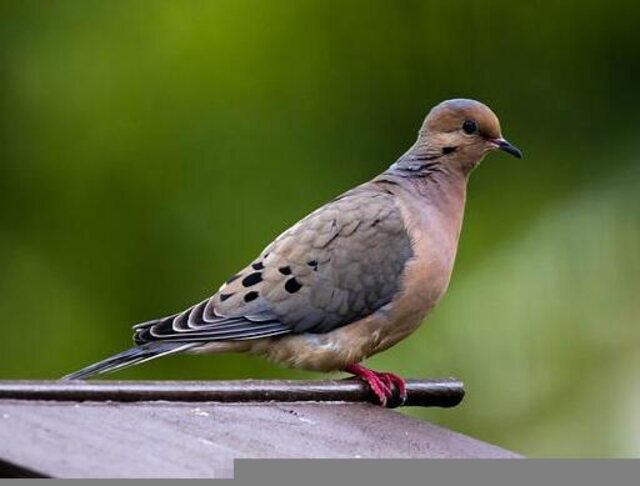
- Length: 9.1-13.4 in (23-34 cm)
- Weight: 3.4-6.0 oz. (96-170 g)
- Wingspan: 17.7- 19 in (45 cm)
- Scientific Name: Zenaida macroura
- Frequency of Occurrence: 32.68%
- Maps: Range Map – Sightings Map
- Sounds: Calls and Sounds
- Where To Find Them: The Mourning Dove is a beautiful bird that can be found in Maryland all year round. However, their numbers peak in the winter months, making it the best time to see them. Here are some of the best places to find Mourning Doves in Maryland during the winter: The Eastern Shore – This region is one of the best places to see Mourning Doves in Maryland, as they are attracted to the open fields and farmland found here. Baltimore County – Another great place to look for Mourning Doves is in Baltimore County, where they can often be seen near wooded areas and suburban gardens. Montgomery County – Finally, Montgomery County is also a hotspot for these birds in winter, particularly around parks and golf courses.
- How to Attract: If you’re looking to add a little avian excitement to your winter, here are a few tips for attracting Mourning Doves. Mourning Doves are seedeaters, so one of the best ways to attract them is by offering a variety of seeds in a feeder. Sunflower seeds are a favorite, but these doves will also eat safflower, millet, and cracked corn.
General Information: The Mourning Dove is a North American species of dove. The habitat consists of temperate to subtropical regions. The diet includes seeds, fruits and invertebrates. It is a winter visitor in some areas. The Mourning Dove is a medium-sized bird with a long tail and pointed wings. It has a grayish-brown back and wings, and a white underside with black spots on its breast.
Its head is grayish-brown, with a dark line running down the center of its neck. The Mourning Dove ranges in size from 9 to 13.5 inches in length and has a wingspan of 17 to 19 inches. The Mourning Dove’s natural habitat is open woodlands, fields and gardens. It can also be found in urban areas such as parks and neighborhoods where there are trees or shrubs for cover.
Related: Facts About Mourning Doves – 10 Things You Need To Know!
European Starling
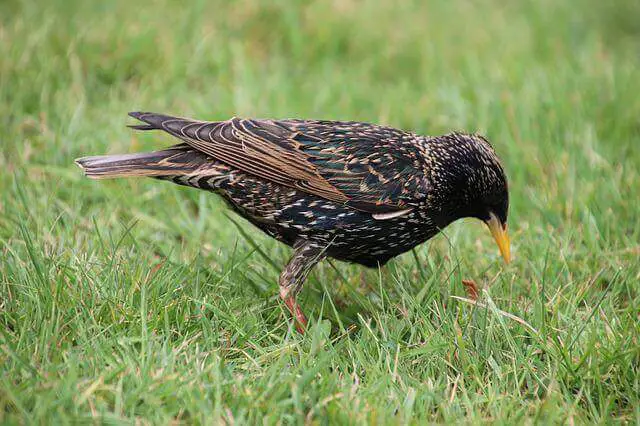
- Length: 7.9-9.1 in (20-23 cm)
- Weight: 2.1-3.4 oz. (60-96 g)
- Wingspan: 12.2-15.8 in (31-40 cm)
- Scientific Name: Sturnus vulgaris
- Frequency of Occurrence: 29.17%
- Maps: Range Map – Sightings Map
- Sounds: Calls and Sounds
- Where To Find Them: In the winter, European starlings can be found in a number of different locations in Maryland. One of the best places to see them is at the National Wildlife Visitor Center in Laurel and the Chesapeake and Ohio Canal National Historical Park in Williamsport.
- How to Attract Them: Though common, European starlings are not always easy to spot in winter. The best way to find them is to look for flocks of birds roosting in trees or on power lines. The birds often form large roosts of 100 or more individuals during cold weather.European starlings are most active at dawn and dusk, so these are the best times to look for them. The birds will also come to bird feeders that offer a mix of seeds, particularly sunflower seeds.
General Information: The European Starling is a species of true thrush. The bird is also known as the common starling, or simply the starling in the UK and Ireland. It is about 20 cm long and has glossy black feathers with speckles of white. The adult male has yellow eyes and a dark bill in winter and a yellow bill during breeding, while the female has brown eyes and pinkish bill. The juvenile bird is similar to the adult female but with browner plumage.
The European starling is found across Europe, Asia and North Africa. It is a very common bird in urban areas, parks and gardens. The bird feeds on insects, earthworms, berries and fruits. In winter, the diet of the European starling changes to include more seeds and fruits. The European starling is a migratory bird and many birds travel to Southern Europe or Africa for the winter months.
Related: How To Attract European Starlings To Your Yard Fast?
White-breasted Nuthatch
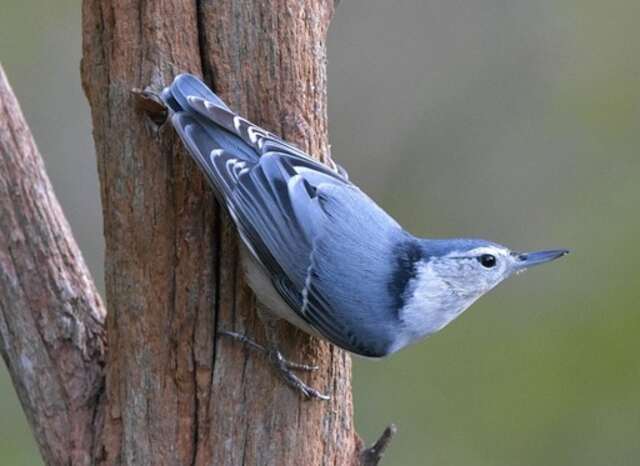
- Length: 5.1-5.5 in (13-14 cm)
- Weight: 0.6-1.1 oz. (18-30 g)
- Wingspan: 7.9-10.6 in (20-27 cm)
- Scientific Name: Sitta carolinensis
- Frequency of Occurrence: 28.75%
- Maps: Range Map – Sightings Map
- Sounds: Calls and Sounds
- Where To Find Them: While they can be found throughout Maryland, there are certain areas where they are more likely to be seen in the winter months. One of the best places to see White-breasted Nuthatches in winter is at Patuxent Research Refuge in Laurel, Maryland. This refuge is home to a large population of these birds, and visitors can often see them flitting about in the trees. Another good spot for seeing White-breasted Nuthatches is Sandy Point State Park near Annapolis.
- How to Attract Them: White-breasted nuthatches are seed eaters and will be attracted to a feeder stocked with sunflower seeds or safflower seeds. You can also place seed cylinders in suet feeders or hang them from branches. Create hiding places: Nuthatches like to nest in cavities, so consider adding a nest box to your yard. You can also provide roosting sites by placing small logs or brush piles in your garden. Offer water: A birdbath or small pond will not only provide drinking water for nuthatches, but it will also be a place for them to bathe and preen.
General Information: The White-breasted Nuthatch is a small bird with a big personality. This acrobatic little bird is a common sight at backyard bird feeders and nature parks across North America. Here are some things you may not know about the White-breasted Nuthatch. The White-breasted Nuthatch has a wide range, stretching from coast to coast in North America. This little bird is most commonly found in woodlands, especially deciduous forests.
The White-breasted Nuthatch is an important part of the forest ecosystem, helping to control insect populations. The diet of the White-breasted Nuthatch consists mainly of insects and nuts. In the winter months, when food is scarce, the White-breasted Nuthatch will visit backyard bird feeders in search of sunflower seeds and other high-energy foods.
Related: How to Attract Nuthatches to your Backyard? Expert Tips!
House Finch
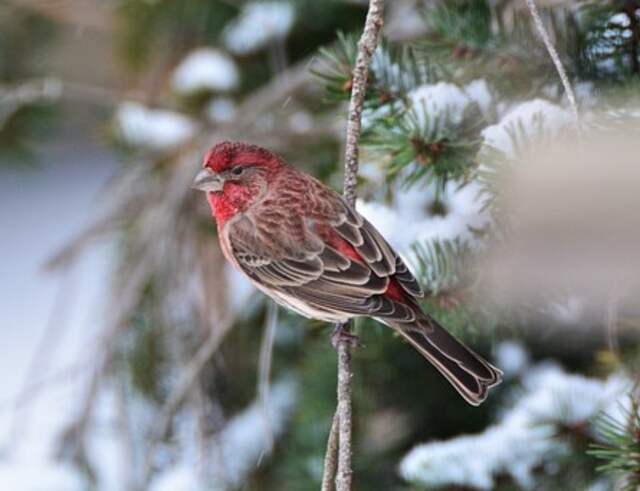
- Length: 5.1-5.5 in (13-14 cm)
- Weight: 0.6-0.9 oz. (16-27 g)
- Wingspan: 7.9-9.8 in (20-25 cm)
- Scientific Name: Haemorhous mexicanus
- Frequency of Occurrence: 25.74%
- Maps: Range Map – Sightings Map
- Sounds: Calls and Sounds
- Where To Find Them: One great place to find House Finches in Maryland during the winter is at the Baltimore and Annapolis Neck National Wildlife Refuge. This refuge is home to many different species of birds, and House Finches are often seen here during the winter months. Another great place to see these birds is at the Blackwater National Wildlife Refuge. This refuge is located on the Eastern Shore of Maryland and is a great place to see many different types of birds, including House Finches. Finally, another excellent location for observing House Finches in Maryland during the winter months is at Susquehanna State Park.
- How to Attract Them: One of the easiest ways to attract house finches in winter is to simply put out a feeder and keep it stocked with fresh birdseed. Finally, don’t forget to offer water for the finches to drink and bathe in. A simple birdbath will do the trick, and if you place it near some bushes or trees, it will provide even more shelter from the elements.
General Information: The House Finch is a small songbird with a wide range across North America. The male House Finch has bright red plumage on its head, breast and back, while the female is a duller brown. These birds are found in open woodlands, edges and brushy areas.
They build their nests in trees or shrubs, often close to human habitation. The diet of the House Finch consists of seeds, fruits and insects. In winter, these birds are often seen at bird feeders, where they will eat sunflower seeds and other bird seed mixes.
Related: How to Attract House Finch to your Yard? (Easy & Fast)
American Robin

- Length: 7.9-11.0 in (20-28 cm)
- Weight: 2.7-3.0 oz (77-85 g)
- Wingspan: 12.2-15.8 in (31-40 cm)
- Scientific Name: Turdus migratorius
- Frequency of Occurrence: 25.23%
- Maps: Range Map – Sightings Map
- Sounds: Calls and Sounds
- Where To Find Them: One of the best places to see American Robins in Maryland is at the Blackwater National Wildlife Refuge. This refuge is located on the Eastern Shore of Maryland and is a great spot for birdwatching. Another place to find American Robins in Maryland is at the Patuxent Research Refuge.
- How to Attract Them: First, provide some water. A small birdbath or even a dish of water set out on your deck or patio will do the trick. Be sure to keep the water fresh and clean, as birds are very particular about such things. You might also consider adding a small fountain or bubbler to the birdbath to create movement and interest. Next, offer some food. During the winter months, robins prefer fruit over insects. So try putting out some apples, oranges, berries or other fruits that will tempt them.
General Information: The American robin is one of the most widespread birds in North America. Its range extends from Alaska and Canada to Mexico and Central America. Robins prefer open habitats such as meadows, farmland, and parks, and are also commonly found in urban areas.
The diet of American Robins consists mostly of insects in the summer, but can also include fruits and berries. In fact, these birds play an important role in dispersing seeds for many different types of plants! Nests are built in trees or shrubs, usually near the ground. The female lays 3-5 eggs, which hatch after about 2 weeks.
Related:
- How To Attract Robins To Your Yard – 7 Best Tips!
- 5 Best Bird Feeders For Robins (Tested & Rated For 2022)
American Goldfinch
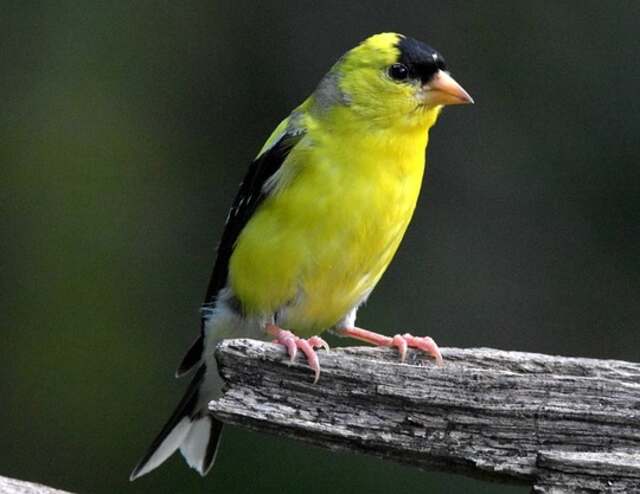
- Length: 4.3-5.1 in (11-13 cm)
- Weight: 0.4-0.7 oz. (11-20 g)
- Wingspan: 7.5-8.7 in (19-22 cm)
- Scientific Name: Spinus tristis
- Frequency of Occurrence: 24.41%
- Maps: Range Map – Sightings Map
- Sounds: Calls and Sounds
- Where To Find Them: Patuxent Research Refuge North Tract: This refuge is located in Laurel and consists of 15 miles of trails through forests, wetlands, and meadows. Keep your eyes peeled for goldfinches while walking along the Woodland Trail or Wetland Trail.
- How to Attract Them: The American Goldfinch, also known as the “wild canary,” is a cheerful little bird that brings a touch of sunshine to even the dreariest of winter days. Here are a few tips on how to attract them to your yard. Goldfinches are attracted to thistle and sunflower seeds, so be sure to put out a feeder with these types of food. They also like nyjer seed, which is available at most pet or wild bird stores. In addition to providing food, you’ll need to give the goldfinches someplace to drink and bathe. A small birdbath or even a shallow dish filled with water will do the trick. Just be sure to change the water regularly so it doesn’t freeze over.
General Information: The American Goldfinch is a small, sparrow-like bird with a yellow body and black wings. The male has a black cap, whereas the female has a brown cap. They are found in open woodlands, meadows, and edges of forests across North America. The American Goldfinch is a seed-eater, and they primarily eat thistle and sunflower seeds.
They will also eat insects in the summer months. In the winter, they are often seen at bird feeders eating nyjer seed. The American Goldfinch is one of the few birds that can actually consume large amounts of fat without getting sick. This makes them well-suited for cold weather survival
Related: Interesting American Goldfinch Facts You Need to Know!
Northern Mockingbird

- Length:8.3-10.2 in (21-26 cm)
- Weight: 1.6-2.0 oz (45-58 g)
- Wingspan: 12.2-13.8 in (31-35 cm)
- Scientific Name: Mimus polyglottos
- Frequency of Occurrence: 22.77%
- Maps: Range Map – Sightings Map
- Sounds: Calls and Sounds
- Where To Find Them: One of the best places to see Northern Mockingbirds in Maryland is at Blackwater National Wildlife Refuge. Located on the Eastern Shore, this refuge is home to a variety of different wildlife species. Visitors can take part in various activities such as hiking, biking, and birdwatching. Another great spot for seeing Northern Mockingbirds is Patuxent Research Refuge. This refuge is located near Laurel and offers a variety of different habitats for wildlife, including forests, meadows, and wetlands.
- How to Attract Them: If you live in an area where they are found, you may be wondering how to attract them in the winter months. One way to attract them is to put out a bird feeder. They are not as attracted to seed as some other birds, but they will eat suet and berries. You can also try putting out a dish of water for them to drink from and bathe in.
General Information: The Northern Mockingbird is a year-round resident of the southern United States, Mexico, and Central America. The bird is also a winter visitor to the southeastern United States. The Northern Mockingbird ranges in length from 9 to 11 inches and has a wingspan of 13 to 15 inches. The bird is grayish-brown above and white below, with two white wingbars.
The tail is long and pointed, and the legs are black. The Northern Mockingbird is an accomplished singer, with a repertoire of more than 200 songs. The bird’s diet consists primarily of insects, berries, and fruits.
Related: How to Attract Mockingbirds to your Yard? (Expert Tips)
House Sparrow
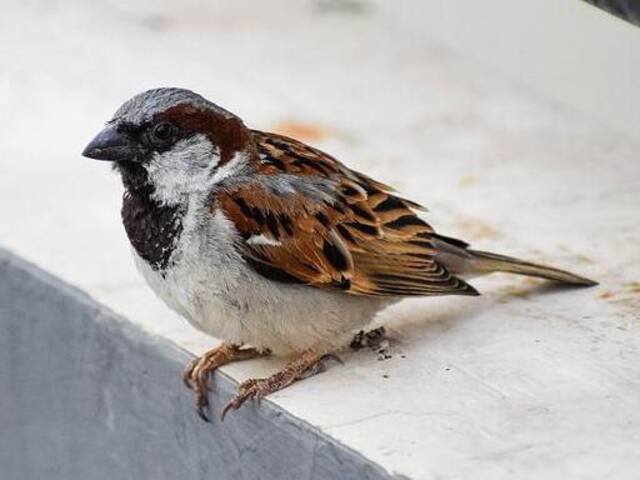
- Length: 5.9-6.7 in (15-17 cm)
- Weight: 0.9-1.1 oz. (27-30 g)
- Wingspan: 7.5-9.8 in (19-25 cm)
- Scientific Name: Passer domesticus
- Frequency of Occurrence: 21.49%
- Maps: Range Map – Sightings Map
- Sounds: Calls and Sounds
- Where To Find Them: One great spot is the Eastern Shore, where these birds can often be seen near agricultural fields. Another good place to look is around urban areas like Baltimore; House Sparrows seem to do well in cities and are often found near buildings and other man-made structures. Finally, don’t forget to look in your own yard!
- How to Attract Them: In order to attract them during winter, there are a few things you can do. First, make sure you have a water source available. This is especially important in areas where natural sources may be frozen over. A simple birdbath or even a dripping faucet can provide the water they need. Second, provide some type of shelter. This could be anything from an evergreen tree to a artificial nesting box. Sparrows will appreciate having somewhere to escape the cold and wind. Finally, offer them a food source that is high in calories and easy to access. Suet cakes and seed mixes are good options. Keep in mind that sparrows are social creatures, so having more than one feeder available will increase your chances of attracting them.
General Information: The House Sparrow is a small, plump bird. The adult male has grayish-brown upperparts and whitish underparts with heavy streaking. The bill is black, and the legs and feet are a dull pink-gray color. The adult female is similar in appearance to the male, but her upperparts are duller brown and her streaking is lighter. Juvenile birds are similar to adults but have darker streaks on their upperparts and paler streaks on their underparts.
The House Sparrow is found in North America, Europe, Asia, and Africa. It prefers open habitats such as farmland, parks, and gardens. The diet of the House Sparrow consists of seeds, insects, and other small invertebrates. In winter months, when food is scarce, the House Sparrow will visit bird feeders in search of meals.
Related: How to Attract Sparrows to your Backyard? (Like A Pro)
Eastern Bluebird
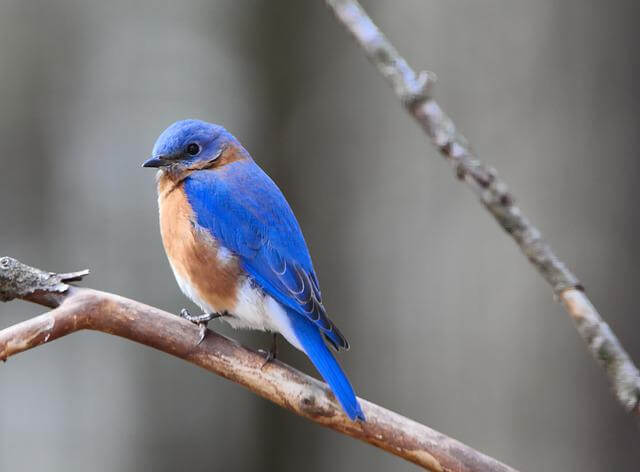
- Length: 6.3-8.3 in (16-21 cm)
- Weight: 1.0-1.1 oz. (28-32 g)
- Wingspan: 9.7-12.5″in. (25-32 cm)
- Scientific Name: Sialia sialis
- Frequency of Occurrence: 20.76%
- Maps: Range Map – Sightings Map
- Sounds: Calls and Sounds
- Where To Find Them: Here are some of the best places to see them in winter: Mount Vernon Estate: This historic estate is home to a variety of birds, including Eastern Bluebirds. They can often be seen perching on the fences or flying around the grounds. Chesapeake Bay: The Bay is a great place to see a variety of birds, including Eastern Bluebirds. Look for them near shorelines or in marshes, where there are plenty of insects for them to eat. Blackwater National Wildlife Refuge: This refuge is home to many different species of birds, including Eastern Bluebirds. They can often be seen in open fields or near forest edges.
- How to Attract Them: One of the best ways to attract an Eastern Bluebird is by providing them with a food source. They are especially attracted to mealworms and berries, so consider placing a bird feeder filled with these items in your yard. You may also put a shallow dish of water next to them so they can drink from that. In addition to food, Eastern Bluebirds also need shelter from the cold weather. You can provide this by placing a small birdhouse in your yard. Make sure it is facing east and has plenty of ventilation holes.
General Information: The Eastern bluebird is a small thrush found in North America. The adult has blue upperparts, a red breast, and white underparts. There are two color morphs, the western and the eastern. The eastern bluebird is slightly larger and has a more orange breast. The Western bluebird is found west of the Rocky Mountains and the eastern bluebird is found east of them.
The range of the Eastern bluebird extends from southeastern Canada to Central America. They are most commonly found in open woodlands, farmlands, and orchards. If provided, they will use nest boxes. The diet of the eastern bluebird consists mainly of insects and berries. During the summer months, they will eat mostly insects such as beetles, grasshoppers, crickets, and caterpillars.
Red-winged Blackbird
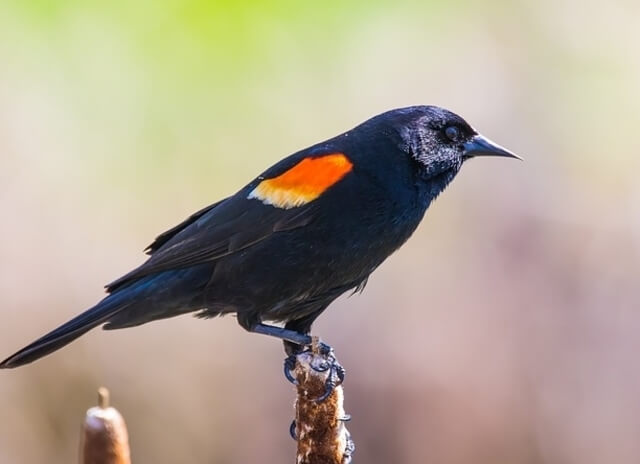
- Length:6.7-9.1 in (17-23 cm)
- Weight: 1.1-2.7 oz (32-77 g)
- Wingspan: 12.2-15.8 in (31-40 cm)
- Scientific Name: Agelaius phoeniceus
- Frequency of Occurrence: 19.01%
- Maps: Range Map – Sightings Map
- Sounds: Calls and Sounds
- Where To Find Them: Red-winged blackbirds are a common sight in Maryland during the winter months. Here are a few of of my favorite locations to see them. Blackwater National Wildlife Refuge – This refuge is one of the best places in the state to see red-winged blackbirds. They can be found in the marshes and along the edges of ponds and lakes. Jug Bay Wetlands Sanctuary – This sanctuary is home to a large population of red-winged blackbirds. They can often be seen perching on tree branches or flying over the wetlands. Patuxent River Park – This park is a great place to see red-winged blackbirds year-round. They can often be found near the river or in the trees along the shoreline.
- How to Attract Them: If you’re lucky enough to have them in your area, there are a few things you can do to attract them to your yard this winter. One of the best ways to attract Red-winged Blackbirds is by providing them with food. These birds are mostly insectivores, so offer up a smorgasbord of bugs for them to feast on. You can do this by leaving some bare patches in your garden for them to hunt through, or by setting out a dish of mealworms or crickets. In addition to food, Red-winged Blackbirds also need water.
General Information: The Red-winged blackbird (Agelaius phoeniceus) is a species of true blackbird in the family Icteridae. It occurs throughout much of North America, from Alaska and Canada to Florida and Central America. It has also been introduced in Hawaii. The red-winged blackbird is sexually dimorphic; the male has black plumage with a distinctive red shoulder patch, while the female is mostly dark brown.
This species is a permanent resident throughout most of its range, although northern birds may migrate south in winter. The Red-winged Blackbird is found in a variety of habitats, including marshes, meadows, fields, and edges of forests. This species feeds on insects, seeds, and berries. The Red-winged Blackbird is one of the most widespread blackbirds in North America. This species is a common winter visitor to many parts of the United States.
Northern Flicker

- Length: 11.0-12.0 in (28-31 cm)
- Weight: 3.9-5.6 oz. (110-160 g)
- Wingspan: 16.5-20.0 in (42-51 cm)
- Scientific Name: Colaptes auratus
- Frequency of Occurrence: 18.19%
- Maps: Range Map – Sightings Map
- Sounds: Calls and Sounds
- Where To Find Them: The Northern Flicker is a beautiful bird that can be found in Maryland all year round. However, winter is the best time to see them as they are more likely to be found in open areas such as parks and fields. Here are some of the best places to see Northern Flickers in Maryland during the winter months: Patuxent Research Refuge – This refuge is located in Prince George’s County and is home to a variety of wildlife, including the Northern Flicker. There are several trails that wind through the refuge, so you’re sure to get a good look at these birds. Eastern Neck National Wildlife Refuge – This refuge is located on an island in Kent County and is only accessible by boat. However, it’s well worth the trip as it’s one of the best places to see Northern Flickers in Maryland.
- How To Attract: Here are a few things you can do to attract them to your yard this winter. One way to attract a Northern Flicker is by putting out a suet feeder. Suet is a high-fat bird food that they need to help them stay warm in the cold weather. You can find peanut butter suet at your local hardware or pet store. Another method to lure these birds is to provide a water source. In the winter, water can be hard to come by for birds so if you have a birdbath or even just a shallow dish of water, they will be sure to appreciate it.
General Information: The Northern Flicker is a member of the woodpecker family that is found throughout North and Central America. They are large birds with a reddish brown back and wings, and a black and white spotted breast. The male has a red patch on the back of its head, while the female has a brown head. Northern Flickers are known for their loud “kik-ker” call, which can be heard year-round.
These birds are commonly found in open woodlands, forests, and suburban areas. During the winter months, they will often visit bird feeders in search of food. Their diet consists mainly of insects, but they will also eat fruits, berries, and nuts. Northern Flickers are one of the few woodpeckers that are able to migrate long distances.
Related: How to Attract Northern Flickers to your Backyard? (Easy)
Pileated Woodpecker
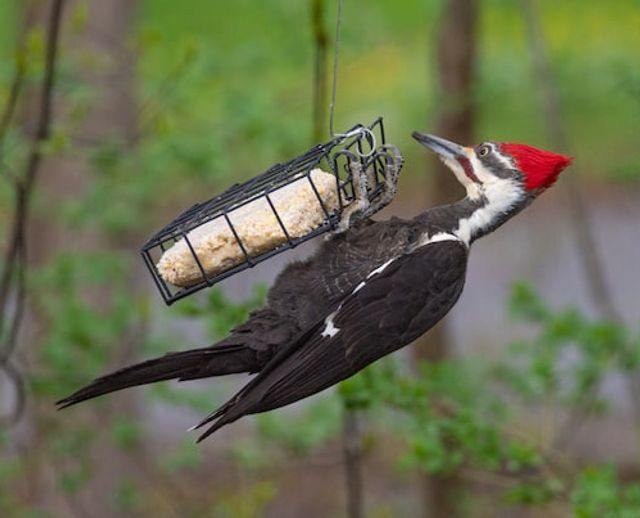
- Length: 15.8-19.3 in (40-49 cm)
- Weight: 8.8-12.3 oz (250-350 g)
- Wingspan: 26.0-29.5 in (66-75 cm)
- Scientific Name: Dryocopus pileatus
- Frequency of Occurrence: 10.05%
- Maps: Range Map – Sightings Map
- Sounds: Calls and Songs
- Where To Find Them: In winter, they are more likely to be found in forests where there is a good supply of dead trees or logs for them to eat insects from. Here are some of the best places to look for Pileated Woodpeckers in Maryland during winter: The first place to look is Patuxent Research Refuge, which is located south of Laurel. The refuge has a large forested area that is perfect for these birds. They can also be found at Blackwater National Wildlife Refuge, which is located on the Eastern Shore.
- How to Attract Them: These birds are especially active in the winter, when they are looking for food. If you want to attract Pileated Woodpeckers to your yard, there are a few things you can do. First, put up a bird feeder. Pileated Woodpeckers love suet, so offer this as a treat in your feeder. You can also put out some nuts and seeds for them to eat. Second, create a habitat that is conducive to these birds. Plant trees and shrubs that will provide perches and nesting sites for the woodpeckers. Make sure there is plenty of deadwood nearby for them to use as well. Finally, be patient!
General Information: The Pileated Woodpecker is a striking bird that is often seen in wooded areas across North America. These birds are renowned for their loud calls, which can be heard from up to a mile away. They are also the largest woodpecker in North America, with a wingspan of up to four feet. The Pileated Woodpecker has a black body with white stripes on the face and wings.
Both the male and female have a red crest, while the female’s have a red stripe on the cheek. Pileated Woodpeckers are found in forests with dense trees and plenty of dead wood for them to excavate their nests. They also need an abundance of insects to eat, which they find by drilling holes into trees. In the winter, Pileated Woodpeckers will sometimes visit backyards in search of food.
Related: How to Attract Pileated Woodpeckers to your Yard (Fast)
Hairy Woodpecker
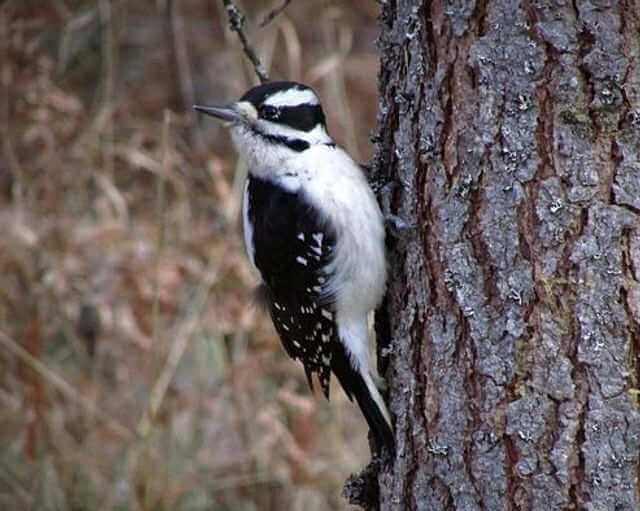
- Length: 7.1-10.2 in (18-26 cm)
- Weight: 1.4-3.4 oz (40-95 g)
- Wingspan: 13.0-16.1 in (33-41 cm)
- Scientific Name: Leuconotopicus villosus
- Frequency of Occurrence: 9.64%
- Maps: Range Map – Sightings Map
- Sounds: Calls and Songs
- Where To Find Them: In Maryland, the best places to see Hairy Woodpeckers in winter are at various state parks and nature reserves. One of the best places to find Hairy Woodpeckers in Maryland is Patuxent Research Refuge, located in Anne Arundel County. This refuge is home to a variety of wildlife, including many different species of birds. The Hairy Woodpecker can often be seen here searching for food on the ground or in trees. Another great place to see Hairy Woodpeckers in Maryland is Susquehanna State Park, located in Harford County.
- How to Attract Them: One of the best ways to attract Hairy Woodpeckers is by offering peanut butter suet. This high-fat treat is perfect for helping them survive the cold winter months. You can find suet cakes at most hardware or pet stores, or even online. Just make sure to hang it from a wire mesh so that smaller birds can’t steal it. Another way to attract Hairy Woodpeckers is with a birdhouse designed specifically for them.
General Information: The Hairy Woodpecker is a widespread and familiar bird of the North American woodlands. It is most often seen in forests, but is also found in parks and gardens. The Hairy Woodpecker is a year-round resident in much of its range, but northern birds may migrate south in winter. The Hairy Woodpecker has a black and white plumage with a long bill.
The male has a red patch on the back of the head, while the female has a white patch. Both the male and female have white stripes on the wings. The Hairy Woodpecker feeds on insects, which it catches by probing into crevices in tree bark. It also eats fruits, nuts and seeds.The Hairy Woodpecker is one of the largest woodpeckers in North America.
Yellow-rumped Warbler
- Length: 4.7-5.5 in (12-14 cm)
- Weight: 0.4-0.5 oz (12-13 g)
- Wingspan: 7.5-9.1 in (19-23 cm)
- Scientific Name: Setophaga coronata
- Frequency of Occurrence: 9.23%
- Maps: Range Map – Sightings Map
- Sounds: Calls and Songs
- Where To Find Them: Here are some of the best locations in Maryland to see Yellow-rumped Warblers in winter: Blackwater National Wildlife Refuge – This refuge is located on the Eastern Shore of Maryland and is a great place to see Yellow-rumped Warblers during their winter migration. The refuge consists of over 30,000 acres of wetlands, forests, and meadows which provide ideal habitat for these birds. Gunpowder Falls State Park – This state park is located just outside of Baltimore and offers a variety of different habitats that are perfect for Yellow-rumped Warblers.
- How to Attract Them: Here are a few tips on how to attract these warblers to your yard this winter. First, provide a water source. A small birdbath or even a dripping faucet will do. Yellow-rumped Warblers are particularly attracted to moving water, so a bubbling fountain or birdbath heater is ideal. Second, offer them a variety of food sources. These warblers are mostly insectivores, so offer them a mix of live and dried mealworms as well as fruit. A good birdseed mix will also attract other small birds that the Yellow-rumped Warbler may associate with.
General Information: The Yellow-rumped Warbler is a small songbird that ranges across North and Central America. These birds are common summer residents in forests and woodlands, but they also occur in a variety of other habitats, including scrubland, grassland, and even urban areas. In the winter, they move south to Mexico and Central America. Yellow-rumped warblers are relatively small birds, measuring just 4.7 to 5.5 inches in length.
They have yellow throats and breasts, with grayish upperparts and white underparts. The males and females look similar, although the males tend to be slightly brighter in coloration. These birds are insectivores, feeding primarily on caterpillars and other small invertebrates. They typically forage high in trees, using their sharp beaks to pick insects off of leaves and branches.
Related Posts:

